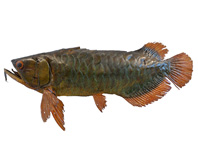Abstract
Saproscincus skinks are restricted to wet forest habitats of eastern Australia. Eleven species have previously been described, with most having small distributions in disjunct areas of subtropical and tropical rainforest. The localized distributions and specific habitat requirements of Saproscincus have made them a key group for understanding the biogeographic history of Australia’s rainforests. Here I describe a new species of Saproscincus from the Melville Range on Cape Melville, north-east Australia. The Melville Range is composed of boulder-fields and areas of rainforest in the uplands, and is highly isolated from other areas of elevated rainforest. All individuals of the new species were found on a moist ridgeline, active on boulders under a rainforest canopy or on boulder-field immediately adjacent to rainforest. Saproscincus saltus sp. nov. is highly distinct in morphology and colour pattern. Of particular interest are its long limbs and digits compared to congeners, which in conjunction with the observed ecology, suggest a long history of association with rock. The discovery of S. saltus sp. nov. extends the distribution of the genus over 100 km north from the nearest congeners in the Wet Tropics region. This species brings the number of vertebrates known to be endemic to the Melville Range to six, which is remarkable for such a small area.

